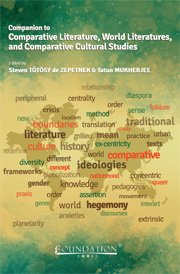Book contents
- Frontmatter
- Contents
- Introduction to the Companion to Comparative Literature, World Literatures, and Comparative Cultural Studies
- PART 1 Theories of Comparative Literature, World Literatures, and Comparative Cultural Studies
- PART 2 Comparative Literature in World Languages
- PART 3 Examples of New Work in Comparative Literature, World Literatures, and Comparative Cultural Studies
- African Literatures and Cultures and the Universal of Motherhood
- World literatures and the Case of Joyce, Rao, and Borges
- Abject Spaces and the Hinterland in Bolaño's Work
- The Motif of Fleeing in Gao's Work
- Arab Fiction and Migration in the Work of Haqqi and Salih
- Sexual Identity and Translation in Prime-Stevenson's Work
- The Notion of Life in the Work of Agamben
- Aesthetics, Opera, and Alterity in Herzog's Work
- An Intermedial Reading of Paley's Sita Sings the Blues
- Painting and Representation in Teaching Balzac
- PART 4 Multilingual Bibliography of Books in Comparative Literature, World Literatures, and Comparative Cultural Studies
- Index
An Intermedial Reading of Paley's Sita Sings the Blues
from PART 3 - Examples of New Work in Comparative Literature, World Literatures, and Comparative Cultural Studies
Published online by Cambridge University Press: 05 April 2014
- Frontmatter
- Contents
- Introduction to the Companion to Comparative Literature, World Literatures, and Comparative Cultural Studies
- PART 1 Theories of Comparative Literature, World Literatures, and Comparative Cultural Studies
- PART 2 Comparative Literature in World Languages
- PART 3 Examples of New Work in Comparative Literature, World Literatures, and Comparative Cultural Studies
- African Literatures and Cultures and the Universal of Motherhood
- World literatures and the Case of Joyce, Rao, and Borges
- Abject Spaces and the Hinterland in Bolaño's Work
- The Motif of Fleeing in Gao's Work
- Arab Fiction and Migration in the Work of Haqqi and Salih
- Sexual Identity and Translation in Prime-Stevenson's Work
- The Notion of Life in the Work of Agamben
- Aesthetics, Opera, and Alterity in Herzog's Work
- An Intermedial Reading of Paley's Sita Sings the Blues
- Painting and Representation in Teaching Balzac
- PART 4 Multilingual Bibliography of Books in Comparative Literature, World Literatures, and Comparative Cultural Studies
- Index
Summary
Abstract: In her article “An Intermedial Reading of Paley's Sita Sings the Blues” Ipshita Chanda discusses the film text of Nina Paley's 2008 animation film, a culturally reconceptualized version of Válmíki's Sanskrit epic Rámáyana. Chanda discusses the film as an intermedial retextualization of the Rámáyana in the film where media boundaries and genres are crossed in “textual,” audio, and visual media. The basic premise from which Chanda proceeds is that the condition of intermediality in film is produced by a “conceptual fusion” of different media which, in turn, are analyzed using theories of reception and contact between different media across time, space, and cultures with regard to “source” text and “received” text.
Chiel Kattenblatt defines intermediality as “those co-relations between different media that result into a redefinition of the media that are influencing each other and a resensibilization of perception. Intermediality, unlike transmediality, assumes not so much a change from one medium to another medium but rather a co-relation in the actual sense of the word, that is to say a mutual affect … Time and space are still the two main dimensions by which we distinguish media from each other and determine their specificity. Such a determination of the specificity of media is usually related to their materiality, although we may notice in the media comparative discourse there is apprehensiveness about ascribing the specific features of a medium to its materiality” (6–7).
- Type
- Chapter
- Information
- Companion to Comparative Literature, World Literatures, and Comparative Cultural Studies , pp. 472 - 483Publisher: Foundation BooksPrint publication year: 2014

